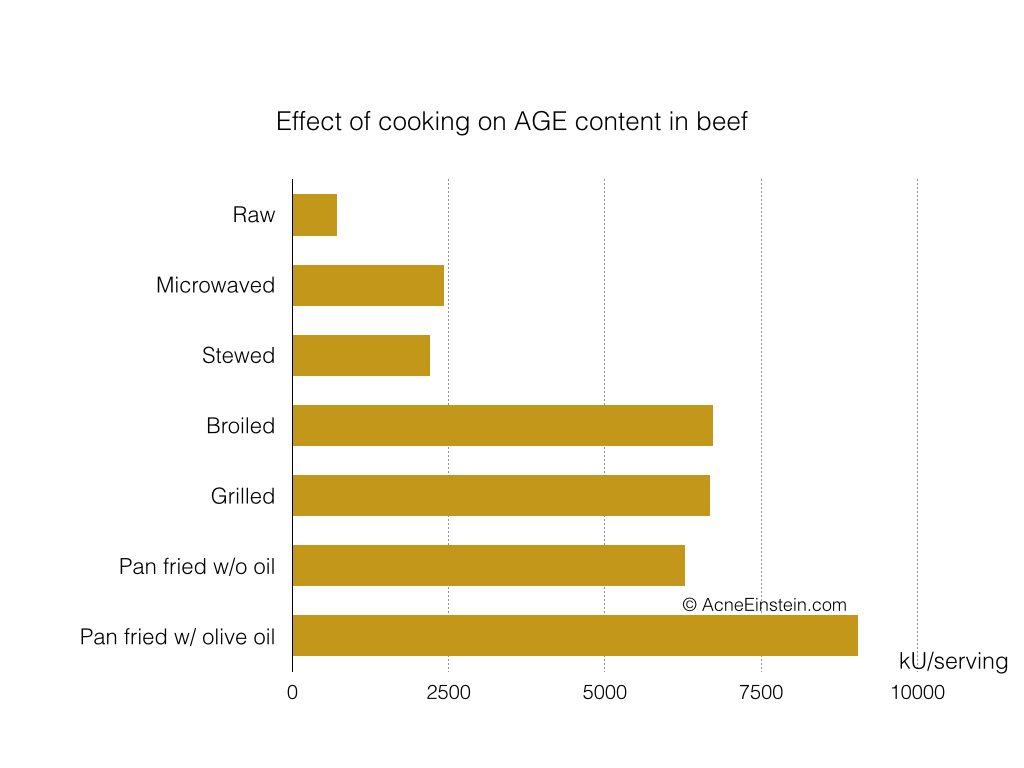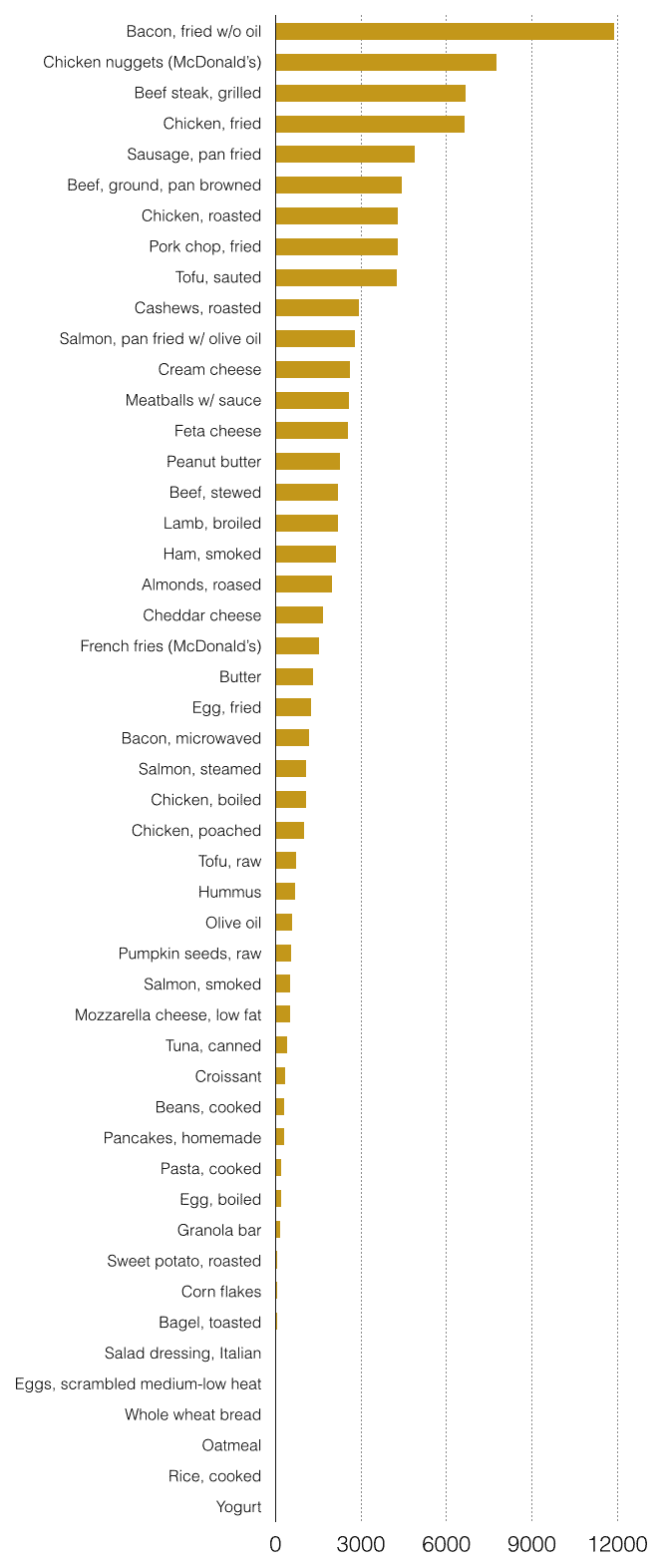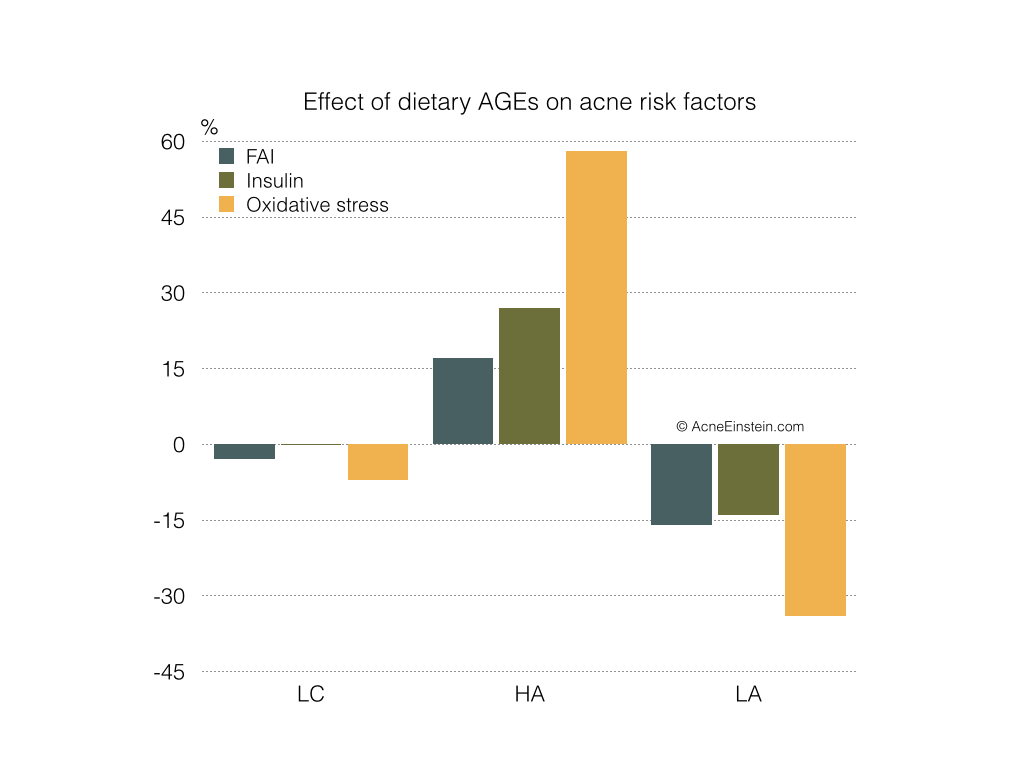Advanced glycation end products (AGE) are compounds that form when proteins or fats combine with sugars, as a result of glycation. AGE are also known as glycotoxins. From Wikipedia: “These harmful compounds can affect nearly every type of cell and molecule in the body and are thought to be one factor in aging and in some age-related chronic diseases.”
As we’ll see in this chapter, AGEs are key players in many of the distal cause of acne, namely inflammation and hormones.
Sources
We are exposed to AGEs in many ways. They are generated in the body as a result of high blood sugar levels, and they are formed in food during cooking. In this section, we’ll focus on dietary AGE.
The main way AGEs form is when you cook foods with protein and/or fat using high-temperature dry heat; think frying, grilling, roasting, etc. AGEs are formed even in foods that seem to lack carbohydrates, such as meats and animal products.
Dr. Uribarri analyzed AGE content of 549 common foods. His analysis included foods in their raw form as well as cooked in various ways. His results show the drastic increase in AGE from different cooking methods (expressed as kU/serving). This graph shows the amount of AGEs in beef cooked using common cooking methods.

Source: Uribarri, J. et al. Advanced glycation end products in foods and a practical guide to their reduction in the diet. J Am Diet Assoc110, 911–16.e12 (2010). https://www.ncbi.nlm.nih.gov/pmc/articles/PMC3704564/
As you can see, cooking can easily increase the AGE content in foods by 10-fold.
The cooking methods that use dry heat and high temperatures create the most AGEs, whereas cooking techniques that use water or low to medium temperatures cause much less damage. The safest cooking methods include:
- Boiling
- Steaming
- Microwave cooking
- Pan frying in low to medium heat
- Stewing
- Poaching
- Slow cookers
It’s important to keep in mind that cooking temperature is much more important than cooking time. A food cooked for a short time in high heat will have much more AGEs than a food cooked for a long time in low temperature.
The AGE content in foods varies a lot. The graph below shows AGE content (as kU/portion) for selected foods.

Meats and animal foods are usually the largest dietary AGEs sources, followed by nuts and cheeses. Among meats, beef is the highest in AGEs, followed by pork, chicken, and seafood. Eggs are relatively safe.
Aside from tofu and nuts, most vegetarian foods have very few AGEs.
For more detailed discussion on AGE sources, please read Dr. Uribarri’s paper (link). Scroll down a bit until you see Table 1, which lists the AGE content of all the 549 food studied. You’ll find the table under the ‘METHODS’ headline. I also recommend you’ll read the ‘RESULTS AND DISCUSSION’ section.
Cooking tip: Use acidic marinades
Aside from cooking foods at lower temperatures, marinading meats with acid (lemon juice, vinegar, etc.) also reduces AGE formation. Dr. Uribarri’s results show acid-marinated meats can have 20 to 30% fewer AGEs than non-marinaded meats cooked the same way.
Smoking
AGEs also form when tobacco leaves are dried, making smoking another source of AGEs exposure. Cigarette smoke contains AGEs, and during inhalation these are absorbed in the lungs. AGEs in cigarette smoke can also damage the skin.
Guidelines for daily dAGE intake
Nobody has yet established how many AGEs humans can safely eat. But we can get some guidelines from the studies that compared high and low AGE diets. In the papers I read, the low AGE group consumed between 2,500 and 5,500 kU/day, whereas the high AGE group consumed between 15,000 and 20,000 kU/day.
Limiting yourself to, say 5,000 kU/day though means giving up roasted, BBQ’ed, and fried meats in most days.
Also, I’m not suggesting you to calculate AGE content for every meal. Rather, use the AGE values to guide your food choices and make sure most of your foods come from the low-medium end.
Now that I’ve given you the bad news lets’s look at why you should consider limiting your AGE exposure.
Acute effect of high AGE meals
In 2007, German researchers published an interesting study. They fed 20 diabetic patients either high (HA) or low AGE (LA) meals. In both cases, the meals contained the same ingredients, the only thing that varied was the cooking method. HA meals were prepared by frying and broiling whereas the LA meals were steamed and boiled.
In the study, they were looking at how this affects heart disease risk, but we are more interested in oxidative stress (inflammation). After a single HA meal, oxidative stress went up by 20%, whereas the LA meal had no effect.
AGE and inflammation
A 2014 review of how dietary AGEs affect inflammation and aging concluded with the following:
There is evidence in the literature of a positive relationship between inflammatory markers and the dietary intake of AGEs; in addition, the concentration of circulating AGEs appears to be correlated with dietary intake of AGEs. The few intervention studies in humans found mainly a suppression of inflammatory parameters in subjects on low-AGE diets, suggesting that a restriction of AGE intake might prevent inflammation and age related chronic diseases.
Van Puyvelde, K., Mets, T., Njemini, R., Beyer, I. & Bautmans, I. Effect of advanced glycation end product intake on inflammation and aging: a systematic review. Nutr. Rev. 72, 638–50 (2014). https://www.ncbi.nlm.nih.gov/pubmed/25231200
Out of the nine studies comparing low and high AGE diets, 8 showed a reduction in either inflammation, oxidative stress, or insulin resistance. The one study that didn’t show a benefit was done on healthy people. It’s possible the study participants already had low levels of inflammation and the low AGE diet didn’t show additional benefit.
Do AGEs accelerate aging?
The scientists also pointed out that young people who consume a lot of AGE are internally in a similar shape than 60+-year-old individuals who consume less AGEs:
In younger subjects with a high dietary AGE intake, the levels of [inflammatory markers] were as high as those in persons older than 60 years with a low dietary intake of AGE.
Reviews on the health effects of AGEs mention that we don’t have enough human data yet to draw solid conclusions, but we have more than enough data to show AGEs likely affect many distal causes of acne and that this is something you should seriously look into.
Hormonal effects of dAGE
Insulin
We have very little data on how AGEs affect insulin levels in humans. However, a 2012 study done on rats showed that rodents fed a high AGE diet had two times higher insulin levels than rodents fed a regular diet.
And at least two observational studies have shown that blood levels of AGEs independently correlated with insulin resistance. In other words, people with more AGEs in the blood also have higher insulin levels.
Further evidence comes from a 2014 Danish study where 74 overweight women were divided into low and high AGE diets. After four weeks, fasting insulin levels dropped by 9% in the low AGE group and increased by 11% in the high AGE group. Similarly, insulin resistance got worse in the high AGE group and improved in the low AGE group.
Both diets contained similar foods. The main difference was how the foods were cooked.
Androgens
In 2014, Greek researchers conducted an interesting study that showed increasing or reducing AGEs in the diet also affected testosterone levels.
In the study, the researchers put 23 women with PCOS through three 2-month diet phases: a low-calorie diet (LC), a normal calorie diet with high AGE content (HA), and a normal calorie diet with low AGE content (LA). Here are the estimated dietary AGE exposures for each diet phase:
- Baseline (before the study): 10.9
- LC: 9.6
- HA: 16
- LA: 5.7
This image shows how each dietary phase affected androgen, insulin, and oxidative stress levels as compared to the baseline levels before the study. Positive values mean an increase over before the study and vice versa. And since we are talking about hormones and oxidative stress, positive values mean things got worse.
In the graph, FAI means free androgen index, which measures abnormal androgen levels, and oxidative stress basically translates to inflammation.

Source: Tantalaki, E. et al. Impact of dietary modification of advanced glycation end products (AGEs) on the hormonal and metabolic profile of women with polycystic ovary syndrome (PCOS).Hormones (Athens) 13, 65–73 (2014). https://www.ncbi.nlm.nih.gov/pubmed/24722128
That graph should be fairly self-explanatory. Each acne-relevant factor was increased during the HA diet phase and reduced during the LA phase. Oxidative stress shot up by almost 60% during the HA diet phase and dropped by over 30% in the LA diet phase. FAI increased by over 15% and decreased by roughly the same amount during HA and LA diet phases, respectively.
Interestingly, reducing dietary AGEs was more effective than cutting calories in every measure – despite the women in this study being overweight.
Here’s the authors’ conclusion:
The main finding of the present study is that changes in dietary AGEs parallel changes in insulin sensitivity, oxidative stress and hormonal status.
We can’t conclude from this that dietary AGEs caused these changes. Rather, it’s the low AGE style diet that caused them. During the HA phase, the participants were asked to eat a lot of protein foods cooked at high temperatures (grilled, broiled, baked) as well as nuts and sodas. Fried foods were not allowed at all.
During the LA phase, they were asked to limit red meat, poultry, and fish consumption, and to cook at lower temperatures (steaming, boiling, poaching, stewing). They were also encouraged to eat more pasta, legumes, and boiled vegetables.
Given that the diets during the different phases were different, it’s not possible to lay all the blame on AGEs, and that’s why I said that it’s the low AGE style diet that caused the improvement.
We still don’t know why AGEs affect testosterone and androgen levels. Scientists speculate it comes down to oxidative stress. AGEs accumulate in tissues and cause damage. This can cause insulin resistance and trigger androgen release from adrenals and ovaries/testes.
The effect of AGEs on skin health and aging
AGE have a direct effect on skin health and aging. Dr. William Danby expressed it so in his 2010 paper on sugars and aging:
The most important concept in understanding the relationship of sugars to aging is that the simple act of cross-linking two collagen fibers will render both of them incapable of being repaired through the usual process of remodeling.
Danby, W. F. Nutrition and aging skin: sugar and glycation. Clinics in dermatology28, 409–411 (2010). https://www.sciencedirect.com/science/article/pii/S0738081X10000428
While this quote talks about sugar, AGEs formed by heating food have the same effect.
There’s very little solid evidence on how AGEs in the skin affect the proximal causes of acne. However, if you asked me to put money on the line, I would say AGEs in the skin increase oxidative damage and make acne-prone skin more likely to breakout. From a 2012 review of AGEs in skin aging, AGEs in the skin:
- AGEs can trigger the release of inflammatory messenger molecules in the skin cells. These ‘fire alarm’ molecules are also released when skin cells are exposed to acne-causing bacteria.
- AGEs make skin cells more sensitive to UV light and other external stimuli.
- Upon UV exposure, AGE molecules release large amount of free radicals.
These may or may not be enough to trigger acne, but it’s safe to say AGEs aren’t doing your skin any favors and certainly don’t make it less likely for you to get acne.
AGEs and gut problems
AGEs may also affect gut health. Preliminary evidence suggests that AGEs can trigger an inflammatory response in the gut lining that increases intestinal permeability. Evidence from Chron’s disease patients shows that inflamed parts of the gut show far more evidence of AGE exposure than non-inflamed parts.
AGEs may also have an adverse effect on gut bacteria. Cooking foods at high temperatures affects some proteins and carbohydrates in a way that the human digestive enzymes can’t break them down. In other words, they become indigestible. However, the harmful bacteria in the gut have no problems eating them. Test tube studies show that AGEs promote the growth of harmful bacteria in the gut, and this is speculated to be one reason why red meat is linked to colon cancer.
Take home message and practical implications
There’s very good evidence to show that dietary advanced glycation end products are detrimental to human health. Reducing AGE in the diet has been shown to balance hormones associated with acne. Similarly, eating fewer AGEs has been demonstrated to reduce inflammation.
Women prone to hormonal-type acne and anyone with inflammatory-type acne should consider a low AGE diet.
On this page, we only looked at factors relevant to acne, but AGEs have also been linked to cancers, heart disease, and other health problems.
Fortunately, reducing your exposure to dietary AGE is easier than many other diet changes. With a few exceptions, you can still keep eating the same foods. Just switch to lower temperature cooking methods.

